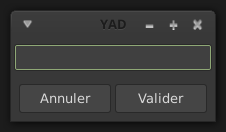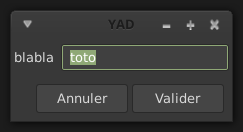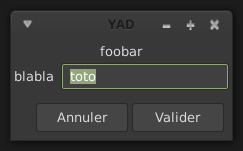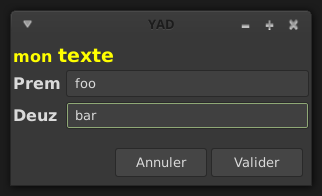-
yad > les formulaires et les saisies
GENERALITES
yad --entryyad --entry --entry-label="blabla"
yad --entry --entry-label="blabla" --entry-text="toto"
yad --text-align=center --text="foobar" --entry --entry-label="blabla" --entry-text="toto"
Récupération de la saisie
#!/bin/sh INPUTTEXT=`yad --entry --entry-label="saisie"` yad --text="Vous avez saisi : $INPUTTEXT"
FORMULAIRE
#!/bin/sh ~$ yad --height=150 --width=300 --text="<span foreground='yellow'><b><big>mon <big>texte</big></big></b></span>" \ --form --field="<b><big>Prem</big></b>" --field="<b><big>Deuz</big></b>"
TYPES DE DONNÉES
password
yad --entry --entry-label=password --hide-text
nombres
yad --entry --numeric
Uses a spin button for text entry and won’t allow character entry. Entering data can be manually typed in.
There are 6 decimal points. EG: 100.000000
AUTO-COMPLETION
--completionsearches the data in the script and matches it against your input.
#!/bin/sh yad --completion --entry="Name:" "" \ "Pink Floyd" "King Crimson" "Portishead" "Primus" "Beatles" | while read line; do ENTRY=`echo $line | awk -F',' '{print $1}'` echo $ENTRY done
Now after typing b
ICONES
yad --entry --licon=/usr/local/lib/X11/pixmaps/home48.png
Notice the icon justified to the left of the entry box.
yad --entry --licon=/usr/local/lib/X11/pixmaps/home48.png --licon-action=rox
Click on the rox icon in the entry field to launch rox.
yad --entry --ricon=/usr/local/lib/X11/pixmaps/home48.png
Notice the icon justified to the right of the entry box.
yad --entry --ricon=/usr/local/lib/X11/pixmaps/home48.png --ricon-action=rox
Click on the rox icon in the entry field to launch rox.
EXPANDER
yad --entry --expander="click here to show entry"
——>
Whatever you type is parsed like the script below.
#!/bin/sh ANSWER=`yad --entry --expander="click here to show entry"` yad --text="You typed $ANSWER in the entry box"
--entry-label=STRINGSet the entry label text.--entry-text=STRINGSet the initial entry text or default item in combo-box.--hide-textHide the entry text.--completionUse completion instead of combo-box.--complete=TYPEUse specific type for extended completion.TYPEcan beanyfor match any of typed words,allfor match all of typed words orregexwhen typed text treats as regular expression.--editableAllow make changes to text in combo-box.--numericUse spin button instead of text entry. Additional parameters in command line treats as minimum and maximum values, step value and precisions (in that order). All this values are optional. Default range is from 0 to 65535 with step 1.--float-precision=NUMBERSet precision of floating point numbers. By default precision is three digits after point.--licon=IMAGESet an icon on a left side of entry.--licon-action=CMDSpecify a command which will be run when the left icon clicked. Output of command will be set as entry text.--ricon=IMAGESet an icon on a right side of entry.--ricon-action=CMDSpecify a command which will be run when the right icon clicked. Output of command will be set as entry text.--num-outputOutput index of active element instead of text for combo-box entry. Any extra data specified in command line adds as an items of combo-box entry, except of numeric mode.If icon specified and icon action is not given, click on icon just clear the entry. Numeric fields will ignore the icons.
--fontname=FONTNAME This command sets the font type :
yad --width=250 --text-info < hello.txt --fontname="Serif bold italic 20″Form options
http://www.thelinuxrain.com/articles/multiple-item-data-entry-with-yad
http://rpm.pbone.net/index.php3/stat/45/idpl/17003956/numer/1/nazwa/yad
holidays=$(echo "Gold Coast,Bali,Phuket,Sydney,other") yad --title="" --text="coucou" --image="/image/phone.png" --form --date-format="%-d %B %Y" --separator="," --item-separator="," \ --field="Nom" --field="Prénom" --field="Status":RO --field="Date":DT --field="Last holiday":CBE --field="Liste:":TXT \ "" "" "All round good guy" "Click calendar icon" "$holidays"--field=LABEL[:TYPE](TYPE -H,RO,NUM,CHK,CB,CBE,FL,SFL,MFL,DIR,CDIR,MDIR,FN,DT,CLR,BTN,LBLouTXT)Par défaut, le type du champ est une saisie simple.
yad --form --field=LABEL
H - Hidden : mot de passe
yad --form --field=LABEL:H
sortie >
monmotdepass|RO - Read Only
yad --form --field=LABEL:RO "Default Text"
NUM - Numéeique
yad --form --field=LABEL:NUM
yad --form --field=LABEL:NUM "10"
To control a Minimum and Maximum number, say 0.0 - 20.0:
yad --form --field="Number:NUM" 0\!0..20\!1\!1
NOTE : ‘
\‘ escape characters. These are not required in a script but are from the CLI.
Lets set the Minimum to 0.0 and the Maximum to 100.0 with 0.5 increments.
yad --form --field="Number:NUM" 0\!0..100\!0.05\!2
CHK - Check Box
yad --form --field="Number:CHK"
Checked returns True, Unchecked returns False.
CB - Combo Box
note the escape ‘\’ characters.
yad --form --field="ComboBox:CB" One\!Two\!Three
CBE - Combo Box Editable
Combo Box is Editable. In other words you can add data on the fly by typing.
yad --form --field="ComboBox:CBE" One\!Two\!Three
When you press OK in the above example
More Stuff|is returned.CE - Entry with Completion
completes a string from matching data. In the example below There are a number of vehicle makes. If you type h in the entry box you will be given a choice of vehicles listed that begin with h EG: Holden and Honda.
yad --title="Vehicle Makes" --form --field ':CE' 'Toyota!Honda!Fiat!Mitsubishi!Nissan!Bentley!Citroen'
—>
FL - Folder List
yad --form --field="Folder List:FL"
Notice (None) is displayed, this is because a path was not specified. Lets add a path to /root:
yad --form --field="Folder List:FL" /root
SFL - Select FileList
select a file from a list.
yad --form --field="Folder List:SFL" /root
Now you can drill down through the folders, starting at
/root, and select a file. Sortie >/path/filename|MFL - Multiple File List
to select multiple files. You need to hold the CTRL key while left mouse clicking to do so.
yad --form --field="Folder List:MFL" /root
The dialog looks the same as SFL however, when you select multiple files the /path/filenames are separated by a ‘!’
/root/cruise0002.jpg!/root/cruise0003.jpg!/root/cruise0004.jpg|As you can see I selected three files.
DIR - Directory
display a basic directory structure.
yad --form --field="Folder List:DIR" /root
CDIR - Select/Create Folders
yad --form --field="CDIR:CDIR" /root
MDIR - Select Folders Only
yad --form --field="MDIR:MDIR" /root
FN - Font Dialog
yad --form --field="Font::FN"
When you click on the Font Button:
Tip: Did you notice "Font::FN" in the command? The first colon is added to the Label and the second defines the field type.
DT - Date Picker
yad --form --field="Date::DT"
Notice the little Calendar in the right of the field. When you click on it, you get a Calendar. Select the date and click on OK. The following is returned: 20/04/16|
CLR - Color Picker
yad --form --field="Color::CLR" "#F507D0"#F507D0couleur par défautNOTE : In the Color name field you can type recognised names like
tealto select a colour.BTN - Bouton
yad --form --field="Button::BTN"
Now we add a command so it will open your default image viewer.
yad --form --field="Image Viewer::BTN" defaultimageviewerLBL : label - TXT : texte
NOTE : Whatever you put inside the quotes before the colon becomes the Label.
yad --form --field="This is a Label Maaate:LBL"
Something similar with the TXT type.
yad --form --field="Text::TXT" "This is a Text box where you can display various information."
Form Example This code was written as a GUI for 01micko’s wonderful little CLI wallpaper maker.
#!/bin/sh yad --title="Make Wallpaper" --form --separator="," \ --field="Name:" "Slacko630" \ --field="Label:" "Slacko-6.3.0" \ --field="Font::FN" "Sans 50" \ --field="Format::CB" "png!svg" \ --field="Width:" "1024" \ --field="Height:" "768" \ --field="Embossed::CB" "Yes!No" \ --field="Gradient Offset::NUM" 0!0..1!0.05!2 \ --field="Gradient Angle::NUM" 0!0..20!0.05!2 \ --field="Colour::CLR" "#008080" \ "" "" "" "" "" "" "" "" "" "" | while read line; do IMAGENAME=`echo $line | awk -F',' '{print $1}'` LABELNAME=`echo $line | awk -F',' '{print $2}'` FONT=`echo $line | awk -F',' '{print $3}'` FORMAT=`echo $line | awk -F',' '{print $4}'` WIDTH=`echo $line | awk -F',' '{print $5}'` HEIGHT=`echo $line | awk -F',' '{print $6}'` EMBOSSED=`echo $line | awk -F',' '{print $7}'` OFFSET=`echo $line | awk -F',' '{print $8}'` ANGLE=`echo $line | awk -F',' '{print $9}'` COLOUR=`echo $line | awk -F',' '{print $10}'` echo $NAME $LABEL $FONT $FORMAT $WIDTH $HEIGHT $EMBOSSED $OFFSET $ANGLE $COLOUR # Convert the colour string xxxxxx to xx xx xx RGB multi="0.003906" red=`echo $COLOUR | cut -c2-3` green=`echo $COLOUR | cut -c4-5` blue=`echo $COLOUR | cut -c6-7` # Convert colour string to decimal fred="$((16#$red))" fgreen="$((16#$green))" fblue="$((16#$blue))" # Scale the decimal numbers to 01micko's range r=$(echo "$fred * $multi" | bc) g=$(echo "$fgreen * $multi" | bc) b=$(echo "$fblue * $multi" | bc) # Separate font type from size FONTY=`echo $FONT | awk '{ $NF = ""; print $0}'` SIZEY=`echo $FONT | rev | cut -d' ' -f1 | rev` # Run mkwallpaper, 01micko's cli application mkwallpaper -n "$IMAGENAME" -l "$LABELNAME" -f "$FONTY" -p $FORMAT -x $WIDTH -y $HEIGHT -s $SIZEY -k $EMBOSSED \ -o "$OFFSET" -z "$r $g $b" -a $ANGLE # Fixed a minor bug in the SVG format. Change pt to px to make sizing work properly . sed -i 's/pt/px/g' /usr/share/backgrounds/"$IMAGENAME.svg" # Display wallpaper defaultimageviewer /usr/share/backgrounds/$IMAGENAME.$FORMAT done--align=TYPEalignement des champs (left,centerouright)yad --form --align=right --field="Label Aligned Right":LB
--columns=NUMBERnombre de colonnes.yad --form --columns=2 --field="Prénom:" "Billy" --field="Age:" "21" --field="Nom:" "Bloggs" --field="Sex::"CB "Male!Female"
NOTE : l’ordonnance des champs va de haut en bas.
--separator=SEPARATORPar défaut le séparateur est
|yad --form --field="Firstname:" "Billy" --field="Lastname:" "Bloggs"
Sortie >
Billy|Bloggs|yad --form --separator="@" --field="Firstname:" "Billy" --field="Lastname:" "Bloggs"Sortie >
Billy@Bloggs@--item-separator=SEPARATORSet the separator character for combobox or scale data.You may have noticed on the
--columnscommand I used a CB (Combo Box). We want to add a few items to the CB so we need to use a separator character to separate them. The default character is the exclamation mark !yad --form --field="Sex::"CB "Male!Female!Other"
Output:
Make|Now lets be bold and change both default separators, the --separator and --item-separator.
yad --form --separator=" " --item-separator="," --field="Sex::"CB "Male,Female,Other" --item-separator=","
The GUI looks the same but the CB choices are now separated by a comma instead of an exlamation mark and the pipe has disappeared from the end of the output. I selected Other and clicked on OK. Output: Other
--date-format=PATTERNSet the format for the returned date.yad --form --separator=" " --date-format="%-d %B %Y" --field="Date:":DT
Click on the little calendar, choose a date, click OK. then click OK again. Output:
26 April 2016Icons box options
--read-dir=DIRECTORY--compact--generic--stdin--item-width--term=PATTERNUse specified pattern for launch command in terminal (default: xterm -e %s)--sort-by-name --descend--field=LABEL[:TYPE]Add field to form.Type may be
H,RO,NUM,CHK,CB,CBE,CE,FL,SFL,DIR,CDIR,FN,MFL,MDIR,DT,SCL,CLR,BTN,FBTN,LBLorTXT.
H- hidden field type. All characters are displayed as the invisible char.
RO- field is in read-only mode.
NUM- field is a numeric. Initial value format for this field isVALUE[!RANGE[!STEP![PREC]]], whereRANGEmust be in formMIN..MAX. `!’ is a default item separator.PRECis a precision for decimals.
CHK- checkbox field. Initial value is a case insensitive boolean constant (TRUEorFALSE).
CB- combo-box field. Initial value is a listVAL1!VAL2!…. The separator is the same as inNUMfield. Value started with `^’ threats as default for combo-box.
CBE- editable combo-box field. Initial value same as for combo-box.
CE- entry with completion. Initial value same as for combo-box.
FL- file selection button.
SFL- field for create file.
DIR- directory selection button.
CDIR- field for create folder.
FN- font selection button. Initial value same as in font dialog.
MFL- select multiple files. Value of this field is a list of files separated byitem-separator.
MDIR- select multiple folders. Value of this field is a list of folders separated byitem-separator.
DT- date field.
SCL- scale field. Value of this field in a range 0..100.
CLR- color selection button. Output values for this field generates in the same manner as for color dialog.
BTN- button field. Label may be in form text in a formLABEL[!ICON[!TOOLTIP]]where ‘!‘ is an item separator.LABELis a text of button label or gtk stock id.ICONis a buttons icon (stock id or file name).TOOLTIPis an optional text for popup help string. Initial value is a command which is running when button is clicked. A special sympols%Nin command are replaced by value of fieldN. If command starts with@, the output of command will be parsed and lines started with number and colon will be treats as a new field values. A quoting style for value whensh -cis used - a single quotes around command and double quotes around -c argument
FBTN- same as button field, but with full relief of a button.
LBL- text label. If field name is empty, horizontal separator line will be shown.
TXT- multiline text entry. This field is always occupy all of form width.Without type field will be a simple text entry.--align=TYPESet alignment of field labels. Possible types areleft,centerorright. Default is left.--columns=NUMBERSet number of columns in form. Fields will be placed from top to bottom.--separator=STRINGSet output separator character. Default is `|’.--focus-field=NUMBERSet focused field.--cycle-readCycled reading of stdin data. Sending FormFeed character clears the form. This symbol may be sent asecho -e ‘\f’.--item-separator=STRINGSet separator character for combo-box or scale values. Default is `!’.--date-format=PATTERNSet the format for the date fields (same as in calendar dialog).--float-precision=NUMBERSet precision of floating point numbers. By default precision is three digits after point.--complete=TYPEUse specific type for extended completion.TYPEcan beanyfor match any of typed words,allfor match all of typed words orregexwhen typed text treats as regular expression.--scrollMake form scrollable.--quoted-outputOutput values will be in shell-style quotes.--output-by-rowOutput field values row by row if several columns is specified.--num-outputOutput index of active element instead of text for combo-box fields. Additional data in command line interprets as a default values for form fields. A special value@disabled@makes corresponding field inactive. If no extra arguments specified in a command line, data will be readed from stdin, one value per line. Cycled reading means that forNfieldsN+1value will replace the first field. Empty values are skipped when reading from stdin.




